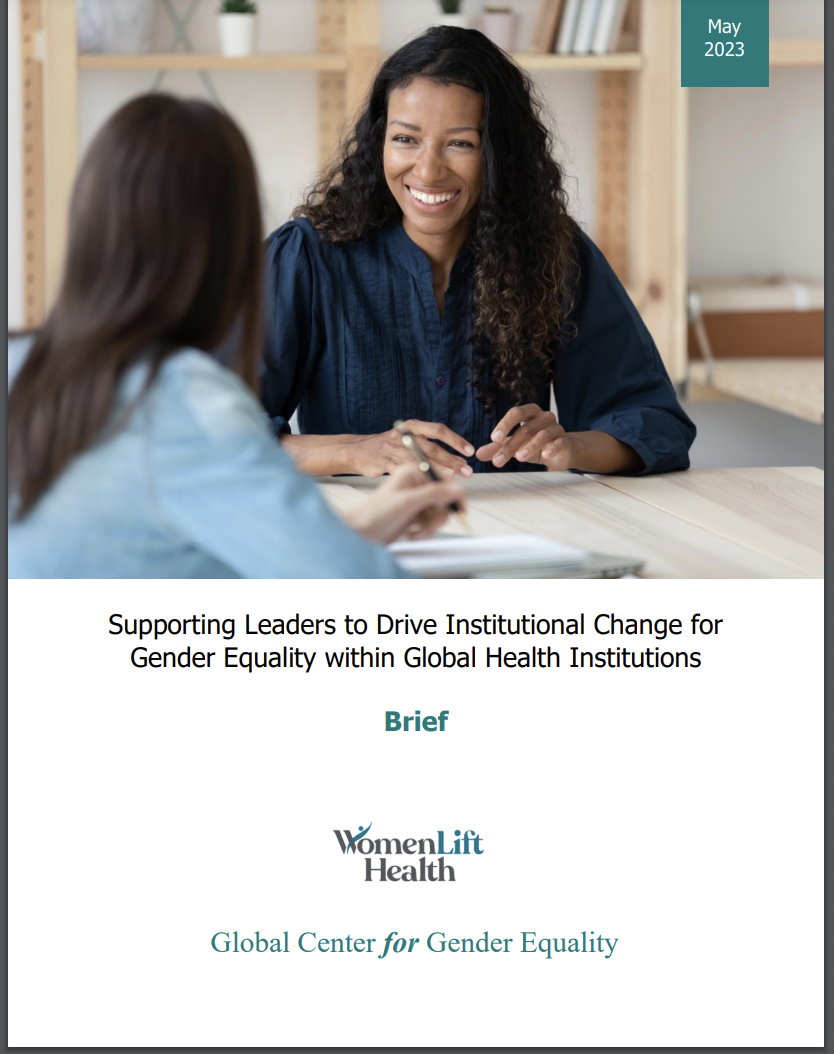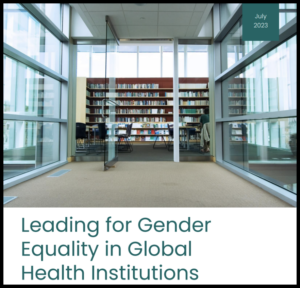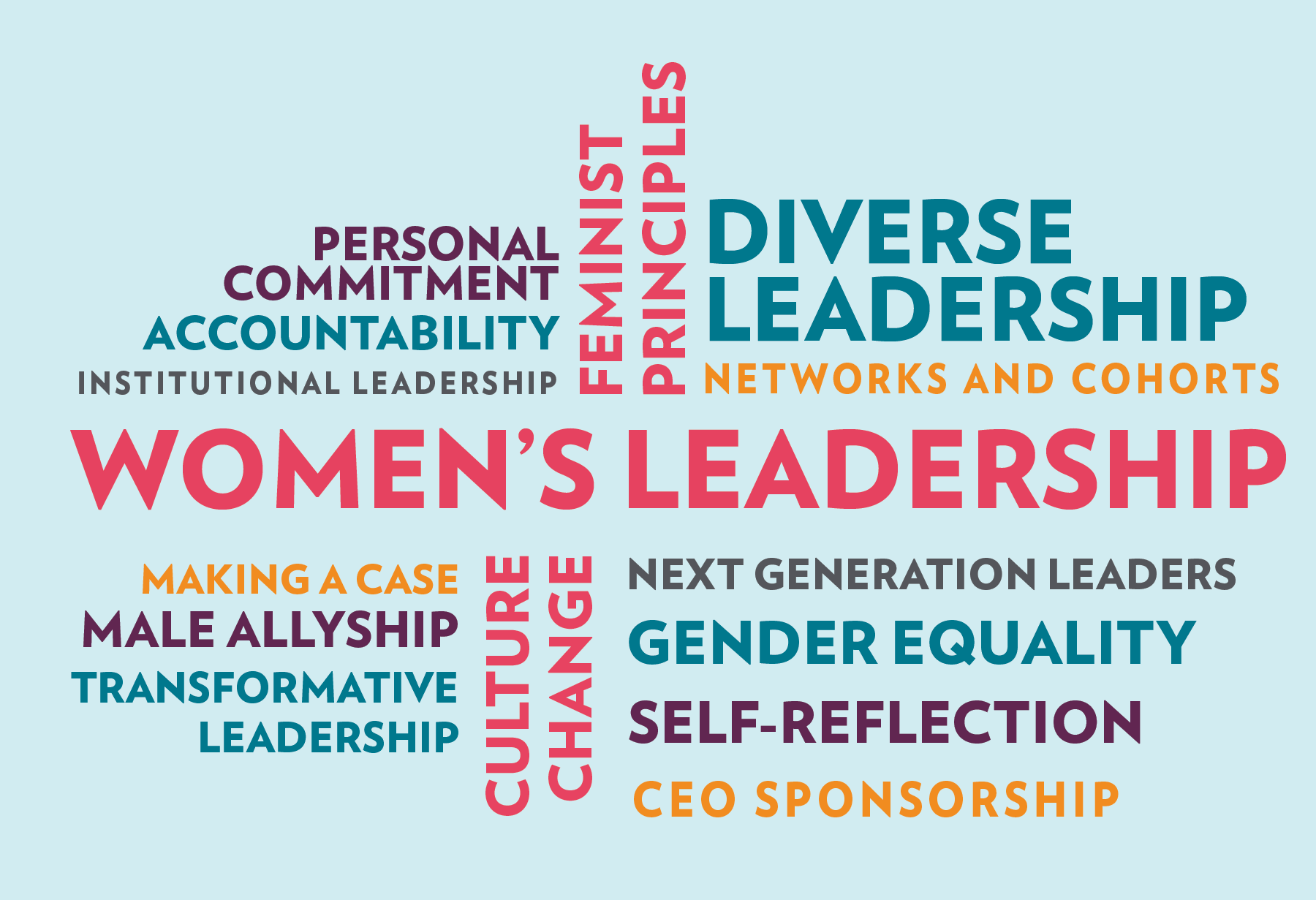Co-authors: Shereen Bhan (WomenLift Health); Jenn Donville and Alex Munive (Global Center for Gender Equality)
“Over nine months, we engaged leaders from public, private, and multilateral GHIs and explored the ecosystem of leadership resources and actors.”
Gender inequality within the health sector undermines the rights of women, girls, and gender-marginalized people and weakens health systems and global health security. Under-representation of women in leadership positions is both a cause and effect of this systemic inequality, but the impact is also demonstrated by systemic gendered bias in service delivery, clinical research, and health outcomes. To address inequality, health systems can be transformed from the outside, through inclusive policies and laws and community pressure and activism, and from within, through bold leadership and actions for reform and transformation.

Lack of representation is both a major driver and a consequence of gender inequality, and addressing this gap must, therefore, be a component of any response. However, if we recognize gender as an intricate network of societal interactions, perpetuated through various formal and informal actions and narratives within institutions, then a comprehensive response must look well beyond representation and purposefully engage the heart of institutional systems, structures, and cultures.
Leaders of global public health institutions will gather at the World Health Assembly this week to discuss ways to accelerate progress toward universal health coverage. Driving gender equality in the global health sector demands strong, committed leadership. WomenLift Health and the Global Center for Gender Equality collaborated to investigate the transformative power of leadership in driving institutional change for gender equality within global health institutions (GHIs).

Over nine months, we engaged leaders from public, private, and multilateral GHIs and explored the ecosystem of leadership resources and actors. Our goal was to identify gaps and opportunities within the leadership and gender discourse and, from them, to identify key recommendations to further the work of organizations like ours to achieve greater impact. We recognized the need for a comprehensive approach, and therefore aimed to look well beyond women’s representation in leadership to explore inequality at the heart of institutional systems, structures, and cultures—and specifically the role that leaders play in generating change.
We were encouraged by the intention, dedication, and motivation of the senior GHI leaders who engaged in our process. It is promising to see these leaders adopting a more comprehensive approach to the promotion of gender equality, recognizing the need for broader and transformative institutional changes rather than focusing exclusively on increasing women’s representation. They showed up, valued the work of advancing gender equality and women’s leadership, shared transparently, and want to continue learning and sharing. This recognition and engagement are the first important steps toward change.

“Leadership matters, and it matters at all levels. It’s not only about who leads—it’s also about how they lead. WomenLift Health is grateful to the institutional leaders who engaged in our shared learning effort and who recognize that Global Health will only be truly global when leaders truly value, learn from, and amplify diverse expertise and lived experiences.”
Shereen Bhan, WomenLift Health
Driving Change
Identifying and addressing barriers to gender equality and the obstacles facing women in leadership roles requires a prolonged and multifaceted commitment by senior leaders. However, there is a tendency within management systems and traditional organizational structures to focus on elements of change that are easily measured and observed. These are the most persistent and well-documented leadership practices or initiatives for promoting gender equality within organizations, and they include the use of organizational data for gender equality, human resource policies such as practices relating to equity in recruitment, gender-responsive working arrangements, and building staff members’ capacity and awareness regarding gender equality. While these are important elements in organizational change for gender equality, our investigation revealed that there are some complex practices with the potential for transformational change that seem to present deeper challenges for leadership.
Our analysis indicates four critical areas that could be strategic for supporting leaders: meaningful accountability, supporting men’s allyship, fostering commitment among next-generation leaders, and adoption of transformative and feminist leadership approaches. In every one of these areas, institutions and leaders need to delve deeper and go beyond performative actions and standardized prescriptions or solutions. There is a clear need to better understand nuance, move away from previously dominant cultures and behaviors, and take on more challenging strategies that reflect the complexity of how change happens within institutions.
Meaningful accountability: Support for gender equality and women’s leadership in an institutional context must begin with sponsorship at the top. But to create sustainable change, it also needs to be permeated through the organizational culture and accountability processes. One leader shared a personal experience that highlights the pressing need for stronger institutional commitment and accountability, saying, “I am struggling because of the recent response with the Roe v. Wade decision. The company wanted to be more neutral. The CEO was getting pressure on both sides. … They eventually sent out a very watered-down message from someone else—not even as a CEO. I was incredibly disappointed and feeling alone in terms of leadership.”
Our key takeaway echoes this sentiment, emphasizing the increasing and unaddressed need for promoting and building meaningful formal and informal accountability in organizations. Leaders need support to understand how to go beyond counting heads and measuring proxy indicators that focus on the symptoms of gender inequality (women in C-suite positions, pay equity, etc.). Furthermore, to identify effective accountability strategies leaders must understand that people and cultures have different motivations and respond to various incentives for change.
“True gender equality in the health sector calls for more than representation—it demands a profound reshaping of our systems, structures, and cultures. The path to this transformation is paved by embracing feminist leadership practices, where leaders must delve deeper, defy normal, and move beyond mere performative actions and standardized solutions.”
Alex Munive, Senior Technical Lead, Global Center for Gender Equality

Supporting men’s allyship: Men are not a monolith, and depending on their age and career stage may be driven by different motivations for and approaches to allyship. Genuine allies amplify women’s voices, educate themselves about inequality, and use their power to support organizational change and social justice without perpetuating domination. As one leader aptly defined, “What is allyship? … I think for men—for white men, for cis-white men—to acknowledge and support and raise up the voices of those around us. To step back, in many cases, to those that nurture and create a supportive environment.”
Organizations and leaders who are invested in promoting men’s allyship need support to develop a comprehensive set of actions to better identify and engage men allies and hold them accountable. This may include examining how and why men can be motivated toward allyship; creating opportunities for men to understand, embrace, and absorb women’s perspectives; and developing effective, solidarity-driven, and accountability-inducing approaches.
Fostering commitment among next-generation leaders: The next evolution in the meaning and promotion of gender equality will be defined by the upcoming generation of leaders. As an interviewee insightfully observed, “Within our company, we have five generations of staff. … What does gender and social inclusion look like to the previous generation, the current, what will it look like in the future? … There are so many nuances.”
For institutions to continue attracting and retaining talented women leaders and gender champions, they will not only need to foster more gender-equal environments but also address previously unrecognized and unaddressed needs. The next generation of leaders needs to be seen, heard, and incorporated into the reimagination of leadership for the future of global health. Their needs must be reflected in institutional environments to foster and sustain momentum toward broader social change.
Adoption of transformative/feminist leadership approaches: Both transformative leadership and feminist leadership are grounded in the principles of social justice, equity, and democratic (or collaborative) processes that emphasize shared power. Traditional styles of leadership often reinforce patriarchal and colonial hierarchies and gendered divisions of labor, where leaders see employee potential and capability through lenses shaped by stereotypes about gender, sex, ethnicity, race, and other factors. Most of the leaders we engaged in our investigation described various transformative and feminist approaches to leadership, though they did not always identify those approaches as such. These approaches to leadership are complex, and it can be challenging to apply them when set against different contexts, institutional cultures, and sometimes-limited parameters for independent change.
A leader’s observation underscores the importance of changing leadership styles: “It needs to be fixed—not just by getting more women but by changing the model of leadership. Health is about communities. You cannot change health outcomes by giving instructions. It requires the public to be engaged. It requires public ownership. That’s a feminist style of leadership.”
Providing pathways for leaders to explore transformative and feminist leadership and the opportunity to incorporate these gradually and at their own pace may be an effective means of getting leaders to adopt new and valuable approaches required to accelerate change.

“Leaders are uniquely positioned to transform unequal power dynamics and discriminatory systems within and beyond the health sector. But responsibility for this transformation cannot be laid exclusively at the feet of women and gender-diverse leaders: leaders of all genders must step up and become agents of change for gender equality by using their positions as leaders to model change, champion change, and design change into their organizational cultures and systems.”
Jenn Donville, Senior Technical Specialist, Global Center for Gender Equality
Leadership Matters
Representation of women and gender-marginalized people in leadership positions is important, but it is not enough to achieve sustainable change. Changes to structural issues and workplace cultural norms at the institutional level are required to effectively address the persistence of gender inequality across the health sector. The critical role of leaders of all genders in advancing an intentional agenda for gender equality in the health sector is clear. Leaders set the tone for organizational behavior and determine which actions and individuals are supported, recognized, or ignored. Our aim at WomenLift Health and GCfGE is to support leaders toward a more nuanced, contextual, and impactful approach to gender equality in global health.


